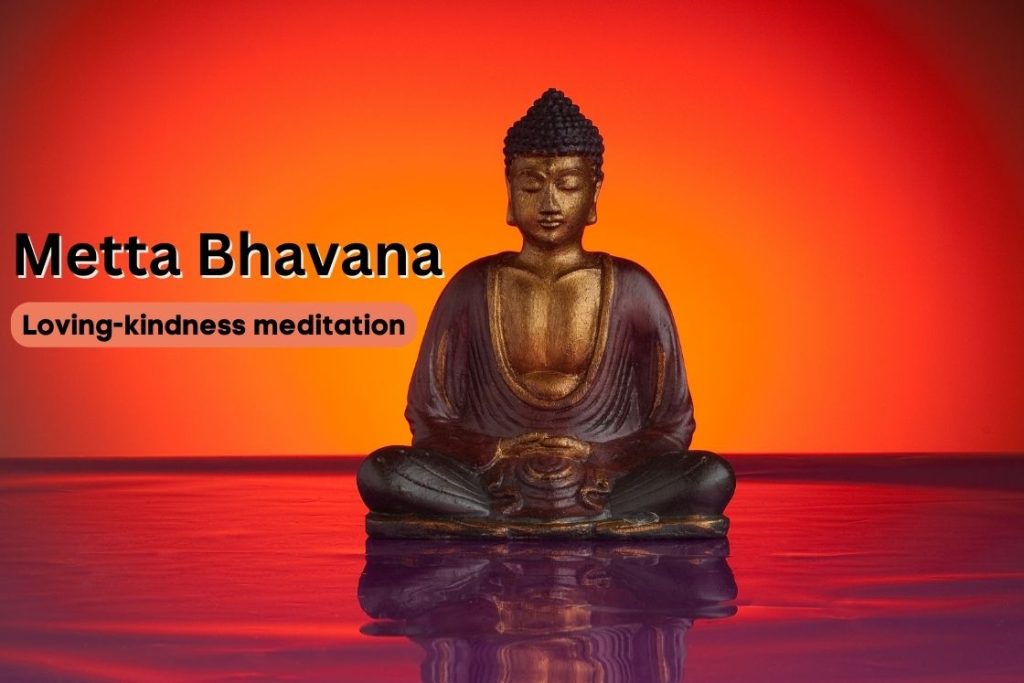
Meditation has been part of Hindu and Buddhist traditions for thousands of years. It helps calm the mind and bring balance to daily life. There are many forms of meditation, from mindfulness to transcendental, each with its own purpose.
One of the most heart-centred practices is Loving-Kindness Meditation, also called Metta Bhavana. This form of meditation teaches us to develop feelings of love, care, and compassion first for ourselves, and then for others. It’s a simple way to open the heart and create more kindness in everyday life.
What is metta bhavana meditation?
Metta Bhavana Meditation, also known as Loving-kindness meditation,, involves the essence of love, benevolence, kindness, and goodwill. Derived from the Pali word “metta,” it is one of the four brahmavihārās, or four immeasurable Buddhist virtues:
Loving-kindness or benevolence (mettā)
Compassion (karuṇā)
Empathetic joy (muditā)
Equanimity (upekṣā/upekkhā)
The roots of metta meditation predate the teachings of the Buddha and can be found in Patanjali’s Yoga Sutra and in Jainism. By silently repeating positive phrases to oneself or others, this meditation cultivates love, kindness, compassion, gratitude, and goodwill.
In this article, we look at the profound practice of Metta Bhavana Meditation. Discover how it can improve our understanding of emotions, enhance our self-compassion, and empower us to spread positivity in the world.
Purpose and benefits of metta bhavana meditation
The main purpose of Metta Bhavana Meditation is to help you truly understand that every person — including yourself deserves happiness. It teaches you to be more forgiving, compassionate, and kind, replacing anger or resentment with positive emotions.
When you visualise yourself sending love and goodwill to others, it naturally brings a deep sense of calm and balance. This practice can also improve your relationships with family, friends, or anyone you may have conflicts with, by helping you see them with more empathy and understanding.
Like other forms of meditation, Metta Bhavana supports emotional healing, reduces stress, and creates inner peace.
1. Cultivating loving-kindness and compassion
Metta meditation encourages self-compassion because it requires you to say loving words to yourself. The concept is that you need to first love yourself in order to love others. Additionally, negative feelings such as insecurity, judgment, anger, and self-criticism can be lessened by practicing self-compassion.
You acquire the capacity to be unconditionally loving to yourself and to other people through Metta meditation.
2. Developing positive emotions and attitudes
The reciting of positive phrases in metta meditation is one of the reasons your outlook towards yourself and others becomes positive. You are able to reduce negative feelings like anger, frustration, or any form of ill will.
You may even be able to reduce any form of biases you may consciously or unconsciously have towards people. This was proven in a study published in 2014 wherein the volunteers were asked to practice 6-week loving-kindness practice and discussion. It was observed that only people who underwent the loving-kindness meditation had a reduced sense of bias towards a social group.
Having positive emotions and attitudes can also help you develop empathy not only for yourself but for people at large, even animals and plants.
3. Enhancing well-being and happiness
Issues like depression, PTSD, migraines, and tension can be alleviated through the practice of metta meditation. If you are able to take care of your well-being and health, this reflects in your mood and behavior as well. You will experience happiness and joy in your day-to-day activities.
Evidence of these can be seen in various studies published over the years.
Research published in 2014 has shown that people who underwent metta meditation intervention had a significant decrease in migraine pain and emotional tension after just one 20-minute session.
Furthermore, a combination of mindfulness-based cognitive therapy and metta meditation was proven to be effective in reducing symptoms of depression and enhancing the mindfulness level and quality of life of the patients.
For PTSD sufferers, metta meditation proves to be a boon since the first step of metta encourages you to focus on yourself. You are promoting self-love and compassion for yourself so that you can see yourself in a new light.
The results of a pilot study, published in 2013, have shown that veterans who suffer from PTSD benefited significantly in reducing symptoms of depression and PTSD after undergoing a 12-week course on metta meditation.
4. Building stronger interpersonal connections
In the later stages of Metta Bhavana meditation, you are prompted to send love and kindness to people whom you are extremely close with. This is done so that you develop the courage to understand that these people also go through bouts of happiness, sadness, and ill health. It promotes the growth of your positive feelings towards them and allows your relationship to flourish.
You will also be sending love-kindness to people with whom you dislike or have a strained relationship. While this may not help you develop a good relationship with them, bringing them into your meditation urges you to remove negative feelings towards such people.
When you develop good and positive thoughts, feelings, and emotions for others, it shows in your behavior and people will be naturally attracted to you. This enables you to make healthy and strong relationships.
5. Reducing stress and promoting inner peace
Metta meditation develops self-compassion, confidence, self-esteem, and love for your true self. This acts as a catalyst to see yourself in a positive light and focus on the good things about yourself.
Additionally, you are also developing compassion and goodwill for people who are close to you and the world.
When you feel at peace with the outside world, this feeling also gets transmitted within yourself. You will not be harboring any negative emotions, thoughts, or feelings for anyone, even for yourself. Your level of satisfaction with life and gratitude towards it will also increase.
Metta meditation tends to alleviate a pattern of negative thoughts which improves your focus and productivity at work as well.
By becoming mindful, being thankful for your current life, and enjoying each moment, you are paving a path for a stress and anxiety-free life.
Preparing for metta bhavana meditation

Metta Bhavana meditation is an active form of meditation where you have to sit in a meditative position and be mindful of the emotions, feelings, and thoughts that arise in the process.
The entire practice can take about 20-30 minutes to 1 hour to be completed, depending on how much time you are spending in each stage.
You may also practice this meditation while lying down if you are not comfortable sitting for such a long duration or have a medical condition. Just be cognizant that you should not fall asleep.
Just like any other meditation practice, you should choose a quiet and comfortable space, where is minimal to no disturbance. It helps in visualizing the person for whom you are practicing metta and reciting the phrases properly.
You may also create a meditation environment in your room if you do not have a separate space. Place some blankets on the floor to make your seating comfortable. Use incense or scented candles if you feel the smell soothes your mind. You may also use other meditation tools to enhance your meditation practice such as crystals, stones, or mandalas.
Once you have set up your space, choose a meditation position you are most comfortable in. Typically Padmasana (Lotus Pose), Sukhasana (Easy Pose), and Vajrasana (Thunderbolt Pose) are the most used meditative poses. Whatever pose you choose, make sure you are adopting the correct meditation position – straight back, neck aligned with the spine, shoulders pushed back slightly, and relaxed mouth.
Finally, before beginning your meditation, it is beneficial to set an intention. Even though the intention is already specified in the name of this meditation technique, loving-kindness can be spread in various ways. You may set an intention for better health or reduce any pain and suffering in general. Setting an intention helps you focus on your practice.
Five stages of metta bhavana meditation practice
The practice of Metta Bhavana Meditation is usually done in five stages. Each stage helps you build loving-kindness starting from yourself and slowly extending it to others. It’s best to sit in a quiet place where you can relax and stay focused.
Stage 1: Cultivating metta for oneself
Begin to focus on your own body and the feelings it contains. Observe how your inner and outer self likely share qualities like sensitivity, warmth, and kindness. Observe your feelings at this moment and acknowledge that you value your experiences of happiness and unhappiness.
As you become aware of yourself, develop feelings of peace, calm, and serenity, and expand these feelings into love, trust, and strength.
Repeat the following phrases or affirmations mentally:
- “May I be well”: Wish for your overall well-being, encompassing both physical and mental health. May you be in a state of vitality and wholeness.
- “May I be happy”: Extend wishes for happiness and joy in your life. May you experience genuine and lasting happiness.
- “May I be safe”: Cultivate a sense of safety and protection for yourself. May you be free from harm and danger.
- “May I find peace”: Wish for inner peace and tranquility. May you experience a deep sense of calm and serenity in your mind and heart.
- “May I be kind to myself”: Encourage self-compassion and self-care. May you treat yourself with kindness, understanding, and acceptance.
- “May I be free from suffering”: Wish for freedom from any form of suffering or pain. May you find relief from physical and emotional hardships.
If it helps, you can visualize an image of yourself in front of your closed eyes and imagine white light flooding your body as you recite the above phrases. Bask in the warm feelings of this light and let it consume you.
You may also use other phrases that feel close to your heart.
Stay in this stage for at least 5-8 minutes before moving on to the next stage.
Stage 2: Cultivating metta for a loved one
In the second stage of Metta Bhavana meditation, we shift our focus from ourselves to a loved one. This could be a dear friend, spouse, child, close relative, or parent. The aim is to extend the same feelings of love, kindness and well-wishes that we developed for ourselves in Stage 1 towards this person. Here is how you can proceed:
- Choose a loved one: Select someone you deeply care about and with whom you share a strong emotional connection. Visualize their presence in your mind, bringing their image and essence to the forefront of your awareness.
- Develop feelings of love and kindness: Reflecting on the qualities that make this person dear to you, allow feelings of love, kindness, and gratitude to arise inside your heart. Recognize that, like yourself, they also experience moments of happiness and unhappiness, joys and struggles in their lives.
- Repeat phrases or affirmations: Use the same affirmations from Stage 1, but replace “I” with “they” or use their name to personalize the meditation. For example:
- “May they be well.”
- “May they be happy.”
- “May they be safe.”
- “May they find peace.”
- “May they be kind to themselves.”
- “May they be free from suffering.”
- Visualize the projection of loving-kindness: Recite these phrases, imagining a beautiful white light emanating from your heart and enveloping your loved one. Visualize this light carrying your feelings of love, kindness, and well-wishes, surrounding them with warmth, happiness, and protection.
- Stay with the practice: Spend at least 5-8 minutes in this stage, allowing your heart and mind to fully embrace the cultivation of Metta for your loved one. Let the feelings of love and compassion expand within you as you continue to repeat the phrases and visualize the transmission of loving-kindness.
Once you feel a deep connection and genuine warmth towards your loved one, you can proceed to the next stage, where we extend Metta to neutral individuals.
Stage 3: Cultivating metta for a neutral person
In the third stage of Metta Bhavana meditation, we expand our circle of loving-kindness to include a neutral person. A neutral person is someone with whom you neither have a strong liking nor disliking, such as a casual acquaintance, a colleague, or someone you frequently encounter in your daily life. Here’s how to cultivate Metta for a neutral person:
- Choose a neutral person: Bring to mind someone who fits the description of a neutral person in your life. Visualize their presence and hold them in your awareness during this stage.
- Recognize their humanity: Reflect on the fact that this neutral person is also a human being who experiences their own joys, challenges, and moments of happiness and unhappiness. Remind yourself of their shared humanity with you and others.
- Repeat phrases or affirmations: Use the same phrases from the previous stages, adapting them to include the neutral person. For example:
- “May they be well.”
- “May they be happy.”
- “May they be safe.”
- “May they find peace.”
- “May they be kind to themselves.”
- “May they be free from suffering.”
- Cultivate feelings of love and good will: Repeat these phrases, while generating sincere feelings of love, kindness, goodwill, and compassion towards the neutral person. Imagine sending them blessings of happiness, wellness, peace, and all the positive qualities you wish for them.
- Include their name if known: If you know the name of the neutral person, you can include it in the phrases to personalize the meditation and create a deeper connection. For example, “May [Name] be well, happy, safe, peaceful, kind to themselves, and free from suffering.”
- Stay with the practice: Spend at least 5-8 minutes in this stage, allowing your heart and mind to extend Metta towards the neutral person. Embrace the intention of offering love, kindness, and goodwill, even to those with whom you have a more neutral relationship.
Remember, the purpose of this stage is to break down the barriers of indifference and cultivate a genuine sense of care and concern for all beings, including neutral individuals. If your mind wanders or judgmental thoughts arise, gently bring your focus back to the phrases and the visualization of sending loving-kindness.
Once you feel a sense of connection and warmth towards the neutral person, you can proceed to the next stage, where we extend Metta to challenging individuals.
Stage 4: Cultivating metta for a difficult person
In the fourth stage of Metta Bhavana meditation, we challenge ourselves to extend loving-kindness towards a difficult person. This person is someone with whom you have a strained or negative relationship, possibly an “enemy” or someone you harbor strong feelings of dislike or resentment towards. Cultivating Metta for a difficult person is an opportunity for growth, compassion, and healing. Here’s how to approach this stage:
- Choose a difficult person: Select the individual who represents the difficult person in your life. Visualize their presence and hold them in your awareness during this stage. It’s important to note that this practice is not about condoning their actions but about cultivating compassion and understanding.
- Recognize your shared humanity: Reflect on the fact that, like yourself and others, this difficult person is also a human being who experiences their own suffering, challenges, and desires for happiness. Acknowledge their flaws, struggles, and the universal nature of human experiences.
- Shift your perspective: Understand that being kind to this person does not require you to like them or condone their behavior. Instead, it is an exercise in developing empathy, compassion, and understanding of their circumstances and struggles. It is about working on your own capacity for forgiveness and letting go of negative emotions.
- Repeat phrases or affirmations: Use the same phrases as in the previous stages, adapting them to include the difficult person. For example:
- “May they be well.”
- “May they be happy.”
- “May they be safe.”
- “May they find peace.”
- “May they be kind to themselves.”
- “May they be free from suffering.”
- Cultivate feelings of kindness and compassion: As you repeat these phrases, actively generate feelings of kindness, compassion, healing, and positivity towards the difficult person. Focus on the intention of wishing them well, even if it feels challenging at first. If negative emotions arise, acknowledge them, but gently return your attention to the positive feelings you are cultivating.
- Stay with the practice: Spend at least 5-8 minutes in this stage, allowing your heart and mind to extend Metta towards the difficult person. Embrace the opportunity for growth and transformation, as you work on overcoming malice, building empathy, and developing a broader understanding of their circumstances.
Remember, this stage is about your own personal growth and cultivating compassion, not about changing the difficult person or the dynamics of your relationship. If it becomes overwhelming, take breaks or shorten the duration. Be patient and kind to yourself throughout the process.
Once you feel a sense of openness and compassion towards the difficult person, you can proceed to the final stage, where we extend Metta to all beings universally.
Stage 5: Cultivating metta for all beings
The last stage invites you to extend this feeling of loving-kindness to the whole world.
This is done by first thinking of the people you visualized in the first 4 stages, and then gradually extending it to your neighborhood, city, country, and so on.
You can also include animals and pets as you wish them health and well-being.
Currently, there is so much suffering, pain, hatred, and stress in the world that it makes sense to send compassion, unconditional love, kindness, peace and healing to all.
At this stage, sit with your palms open to the sky to visualize yourself sending positivity into the world. Visualizing a scene where all people live in harmony, are free from prejudice, and are well nourished and healthy is a great help in practicing this final stage of metta meditation.
Closing and reflection
Once you have finished your reflection on the last stage of metta meditation, gradually bring your attention to your breath and body. Internalize the feelings and emotions you have felt during the meditation. Gently open your eyes, take a few deep breaths, and keep sitting in the same place as you take in the experience of sending love and kindness to various people.
Keep these feelings, experiences, and thoughts within yourself and revisit them throughout the day.
Helpful tips for practising metta bhavana meditation
Getting used to such a unique practice takes time and effort. This active meditation will require dedication from your end to make it a regular habit.
The method described above is the usual method that is majorly followed. However, as you build consistency, you can come up with a way that suits your preferences. You can also search or make up your own positive phrases basis your relationship with yourself and others.
Moreover, you can inculcate this practice in daily life. Whenever you meet a friend, a loved one, an acquaintance, or someone your dislike, make a conscious and sincere effort to send them love and kindness from your heart.
To encourage yourself to practice, start by solely concentrating only on yourself. While it may not be an easy task to send and accept self-love, this is the easiest way to improve and enhance your practice.
Here are some other tips to follow:
- Keep the visualization at bay for the first few sessions. Only focus on repeating the phrases mentally.
- If you feel you are spending more time on one stage, try setting a timer to spend equal time on each stage. It will also help in keeping you focused on your practice.
- To build positive feelings and phrases for others, think of happy and positive memories. Think of the times when these people were at their best.
- You can imagine various positive and pleasing scenarios such as a beautiful landscape with lush green trees, vibrant flowers, and a clear blue sky. A smiling person may also act as a source of inspiration to personify the feeling of metta.
And last but not least, learn this practice from a teacher before you start practicing it on your own. They might teach you some tips that can make your practice more efficient. You will also have someone from whom you can seek guidance when in need.
Conclusion
Metta Bhavana meditation is a unique Buddhist meditation technique where you are not only working towards the well-being and happiness of yourself but also for the people you know or don’t know. You are reciting many positive phrases for yourself, your loved ones, your acquaintances, your enemy, and then the whole world.
Practicing metta meditation teaches you to be selfless and empathetic and open your heart to others. Being loving-kind to others requires us to put aside our preconceptions, biases, and labels, which is a difficult task. Metta Bhavana meditation is all about opening ourselves up to others with compassion and patience.
If you want to include other meditation techniques in your routine, metta bhavana meditation is something you should explore.




